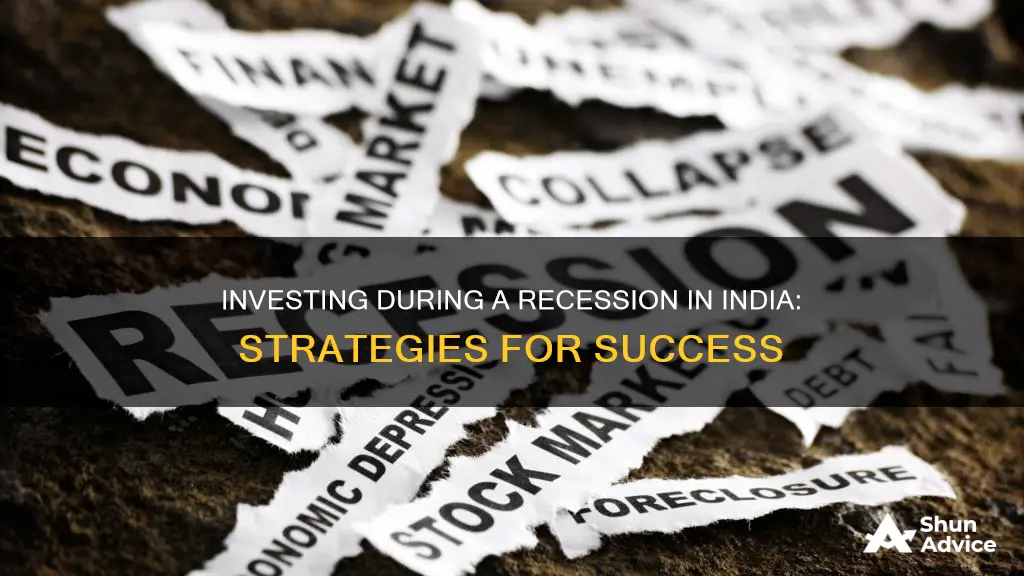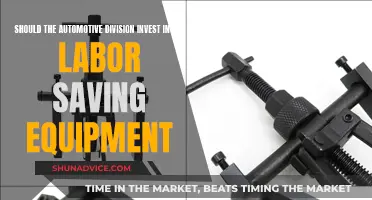
Recessions can be scary, but they also present opportunities for investors. In this article, we will discuss how to invest during a recession in India, outlining the key things to keep in mind and the potential risks and rewards. We will also provide insights into the Indian economy and how it has fared during past recessions. So, whether you are a seasoned investor or just starting, stay tuned as we navigate the complex world of investing during economic downturns.
| Characteristics | Values |
|---|---|
| Savings | 3-6 months of living expenses |
| Discretionary Expenses | Cut down on eating out, entertainment, travel, etc. |
| Debt | Pay off credit cards, car loans, personal loans, etc. |
| Investments | Invest in gold, real estate, defensive stocks, dividend-yielding stocks, fixed-income investments, etc. |
What You'll Learn

Focus on companies with strong balance sheets, low debt, and good cash flow
When investing during a recession, it is important to focus on companies with strong balance sheets, low debt, and good cash flow. These companies are more stable and have a lower risk of going out of business. Here are some things to keep in mind:
- Strong balance sheets: Companies with strong balance sheets are less vulnerable to tightening credit conditions and have an easier time managing their debt. They are also more attractive to investors as they appear to be more stable and less risky.
- Low debt: During a recession, companies with high debt loads may struggle to make their debt payments due to higher-than-average interest rates and decreased revenue. This can lead to bankruptcy or a precipitous drop in shareholder value.
- Good cash flow: A company with positive cash flow indicates that it is generating enough revenue to cover its expenses and debt payments. This is a sign of a well-managed company that is likely to survive a recession.
When looking for companies with these characteristics, it is helpful to use a stock screener to identify large-cap stocks with strong price performance, common stock, and sectors such as consumer staples or healthcare. It is also important to study a company's financial reports to assess its debt, cash flow, and profitability.
Additionally, investing in funds such as exchange-traded funds (ETFs) and low-cost index funds can be a less risky option during a recession, as they provide exposure to a basket of securities rather than a single investment. Funds that track specific sectors, such as consumer staples or healthcare, can be a good choice.
Overall, focusing on companies with strong balance sheets, low debt, and good cash flow can be a prudent strategy for investing during a recession in India.
Becoming an ERISA 3(38) Investment Manager: A Comprehensive Guide
You may want to see also

Invest in defensive stocks, like consumer staples
Defensive stocks in non-cyclical sectors like consumer staples tend to be insulated from the ups and downs of the market. During a recession, defensive stocks can help protect your portfolio.
Consumer staples are essential goods like food and cleaning products, and this category is resilient in economic downturns. These stocks offer steady dividends, making them appealing for long-term income-focused investors. People buy consumer staples regardless of the state of the economy, and defensive stocks like these can offer investors safety during recessionary climates.
Some of the top consumer staples stocks include Procter & Gamble, PepsiCo, Philip Morris, and Unilever. These companies are known for their robust market shares and dividends. Procter & Gamble, for example, is known for its marquee brands such as Tide, Gillette, and Crest, while PepsiCo owns not just its namesake beverage brand but also Frito-Lay and Quaker.
In India, some of the best consumer staples stocks include Hindustan Unilever Limited, ITC Limited, Nestle India Limited, and Britannia Industries Limited. Hindustan Unilever Limited is a major consumer goods company in India with a varied range covering food, drinks, personal care, and home care items. ITC Limited is a diverse company with a significant influence in the consumer staples sector, with products including smoke, packed foods, personal care goods, and stationery. Nestle India Limited is a part of the world food and beverage giant Nestle and offers a wide range of goods, including dairy items, sweets, drinks, and cooked meals. Britannia Industries Limited is one of India's major food companies, known for its famous cookies and bakery goods.
By investing in defensive stocks like consumer staples, investors can benefit from the stable revenue streams, predictable cash flows, and brand loyalty that these companies offer.
Smartly Investing a $2000 Portfolio: A Beginner's Guide
You may want to see also

Avoid speculative stocks
Speculative stocks are a high-risk investment, especially during a recession. These stocks are richly valued based on shareholder optimism, which is tested during economic downturns. Speculative stocks are often under-the-radar opportunities that have not proven their value and are usually small companies with little to no earnings information available.
Speculative stocks are typically the worst performers in a recession. They are the first to be abandoned by investors, who pull their money from the market and seek safe-haven investments. Speculative stocks are also fuelled by market bubbles, which burst when the economy enters a bust cycle.
During a recession, investors should focus on high-quality, defensive stocks in industries that are more recession-resistant, such as utilities, consumer staples, and discount retailers. These stocks tend to experience price appreciation despite the prevailing economic headwinds.
Speculative Stocks are High-Risk, Low-Information Investments
Speculative stocks are often small companies, or "penny stocks," that are not listed on major exchanges. They are usually under-the-radar opportunities that have not yet proven their value. These companies may not provide financial information, making them risky and opaque investments.
Speculative Stocks are Driven by Market Bubbles
Speculative asset prices are often fuelled by market bubbles that form during economic booms. When the economy enters a bust cycle, these bubbles burst, causing speculative stocks to plummet.
Speculative Stocks are the First to be Abandoned by Investors
During a recession, investors rush to safe-haven investments to limit their exposure to market turbulence. Speculative stocks are typically the worst performers in a recession as investors pull their money out of these high-risk opportunities.
Focus on Defensive Stocks and Recession-Resistant Industries
During a recession, it is wiser to invest in defensive stocks in industries that are more recession-resistant. These include utilities, consumer staples such as food and beverages, and discount retailers. These sectors tend to experience price appreciation during a recession, providing a safer investment opportunity.
Build a Portfolio of High-Quality, Recession-Resistant Stocks
Instead of speculative stocks, build a portfolio of high-quality companies with strong balance sheets, low debt, good cash flow, and positive earnings. These companies are better equipped to weather economic downturns and provide more stable investment opportunities.
In summary, speculative stocks are high-risk investments that are particularly vulnerable during recessions. Investors should focus on defensive stocks in recession-resistant industries and build a portfolio of high-quality companies to better protect their investments during tough economic times.
Understanding Portfolio Investment Entities: Definition and Overview
You may want to see also

Dollar-cost averaging can be a good strategy
Dollar-Cost Averaging: A Good Strategy for Investing During a Recession
Dollar-cost averaging is an investment strategy that can be beneficial during a recession. It involves investing a fixed amount of money in the same investment at regular intervals, regardless of the current price. This strategy helps to reduce investment risk and has several benefits during a recession:
Reducing Emotional Investing
Dollar-cost averaging helps take the emotion out of investing. By automatically investing a fixed amount, you stick to a preset course, buying a certain dollar amount of your chosen investment regardless of price fluctuations. This means you're less likely to bail on your investment when prices drop suddenly. Instead, you can view price drops as an opportunity to acquire more shares at a lower cost.
Minimising the Impact of Bad Timing
Determining the exact bottom of a market decline is almost impossible. Dollar-cost averaging helps smooth out how market fluctuations affect your portfolio. If you invest a lump sum right before a market downturn, you risk losing more money. While you might miss investing a large amount just before an upward trend, dollar-cost averaging minimises the impact of market volatility.
Suited for Long-Term Investors
Dollar-cost averaging is designed for long-term investors who adopt a buy-and-hold strategy. It suits those who don't have a large lump sum to invest all at once or those who want to avoid the challenge of timing the market. By investing smaller amounts regularly, you remove the stress of trying to time your trades perfectly.
Simplicity and Discipline
Dollar-cost averaging is a simple strategy. You pick an investment, decide on a fixed amount, and invest it at regular intervals, such as once a month or every payday. Most brokers facilitate automatic investment plans, simplifying the process and helping you stick to your investment strategy.
Reducing Investment Risk
Dollar-cost averaging is a risk-reduction strategy. By investing smaller amounts at regular intervals, you reduce the impact of market volatility on your portfolio. This strategy can be particularly useful in volatile markets, allowing you to ignore emotional highs and lows and avoid the fees associated with frequent trading.
A Consistent Approach
Dollar-cost averaging provides a consistent and disciplined approach to investing. It helps you stick to your investment plan without second-guessing your decisions. This strategy ensures you remain invested and don't miss out on market recovery opportunities due to fear or uncertainty.
CalSTRS Pension2: A Look at Their Investment Portfolio
You may want to see also

Keep emergency savings
Keeping emergency savings is a crucial aspect of financial planning during a recession. Here are some detailed instructions and strategies to help you build and maintain your emergency fund:
Set Clear Savings Goals:
- Aim to save enough to cover your living expenses for at least three to six months. This will provide a cushion in case of unexpected events like job loss or medical emergencies.
- Calculate your monthly expenses, excluding non-essential purchases, and multiply that amount by the number of months you want to save for.
- If this amount seems unattainable, start with a smaller goal, such as $500, which can help cover minor emergencies.
Cut Down on Discretionary Spending:
- Evaluate your expenses and identify areas where you can reduce spending. This could include eating out, entertainment, travel, and vacations.
- Negotiate bills, such as cell phone and cable plans, to lower your monthly payments.
- Avoid unnecessary purchases, especially large ones that could result in extra debt.
Increase Your Savings:
- Set up direct deposits or automatic transfers from your paycheck into your savings account. This helps you save effortlessly without the temptation to spend.
- If you receive a tax refund or a raise, allocate that extra income towards your emergency fund.
- Open a high-yield savings account to maximize the interest earned on your savings. During a recession, interest rates may dip, so consider accounts that offer competitive rates.
Prioritize Emergency Savings Over Debt Repayment:
- While it's important to manage your debt, focus on building your emergency fund first. You can then use any remaining funds to pay off high-interest debt.
- If you're already in debt, consider consolidating it or exploring options like balance transfers to reduce the interest burden.
Maintain a Separate Emergency Fund Account:
- Keep your emergency savings in a separate, easily accessible account. This ensures that you don't accidentally dip into these funds for non-emergency needs.
- Choose an account without withdrawal restrictions and fees, so you can readily access your money when needed.
Remember, building emergency savings is a gradual process, and it's important to stay disciplined and consistent. Even small contributions can make a significant difference during challenging economic times.
Social Media Management: Invest to Gain Online Success
You may want to see also
Frequently asked questions
A recession is a period of declining economic performance that lasts for several months and is marked by GDP contraction, higher unemployment rates, and lower consumer spending. The Reserve Bank of India (RBI) defines it as a prolonged decline in output across the economy. A common indicator is two consecutive quarters of negative GDP growth.
During a recession, the cost of living tends to increase, and job security decreases. Essential items like groceries and fuel become more expensive, and there is a higher risk of job loss or reduced working hours. Finding new employment also becomes more challenging due to increased competition for fewer available roles.
Here are some strategies to consider:
- Invest in strong, defensive companies: Look for companies with strong balance sheets, low debt, positive cash flow, and stable business models. These companies are more likely to weather the economic downturn.
- Focus on recession-resistant sectors: Some sectors tend to outperform during a recession, such as healthcare, consumer staples (groceries, household goods), utilities, and discount retailers.
- Invest in dividend-yielding and fixed-income assets: Dividend stocks and bonds provide routine cash payments, offering stable income during volatile markets.
- Take a long-term approach: Avoid panic selling and focus on long-term wealth accumulation. Recessions can be a good time to buy high-quality assets at discounted prices if you have a long-term investment horizon.







